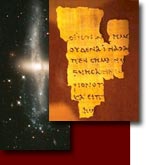| Site Map | Contacts | Links | Newsletter | |
Genesis 1:2
Pre-Creation State
In verse 2 the earth is a barren wasteland and devoid of life. The word paints a picture of an arid desert. It is used in Isaiah 45. This verse seems to assume that matter was all ready here, eternal. It is similar to the state of chaos at the beginning of creation in Greek writings. The closest parallel is in Philo of Byblos. It seems a contradiction in terms for God to create chaos. Nowhere is God said to create tohu wa bohu. Verse 2 is a clear indication that there is no creation in verse 1. Darkness is also part of chaos. Darkness is not the absence of light, but like a black cloud that spreads across the sky (Psalm 18:12; TDOT, Vol. V, 245-59). Darkness also surrounds God (Psalm 97:2). There was an abode for darkness like the snow and wind. It seems also that the wind and spirit are synonymous. The wind is the very spirit or breath of God which make also the words of God, the very emanation from God.
Pictured at the beginning of creation is the earth mingled with (or covered over by) the watery abyss. When the flood waters of the Nile came dirt was mingled with the waters, so that when the flood retreated new soil was left behind to fertilize their fields. Both sweet water and bitter salt water were also mixed together. It is desolate of life like a desert from the Hebrew word tohu. The watery abyss or primeval chaos was shrouded in the darkness of thick clouds. A mighty wind of God blows, or swirls across the face of the waters clearing away the clouds so God can command the light of dawn to shine forth and spread across the sky.
Probably the closest cosmology to the Bible is the Phoenicians. Philo of Byblos says, "He (Sanchuniathon) posits as the source of the universe a dark and windy gas, or a stream of dark gas, and turbid, gloomy chaos. These things were unbound and for the ages were without limit" (Attridge and Oden 1981, 37).
Next - And the Earth Was
Bibliography
